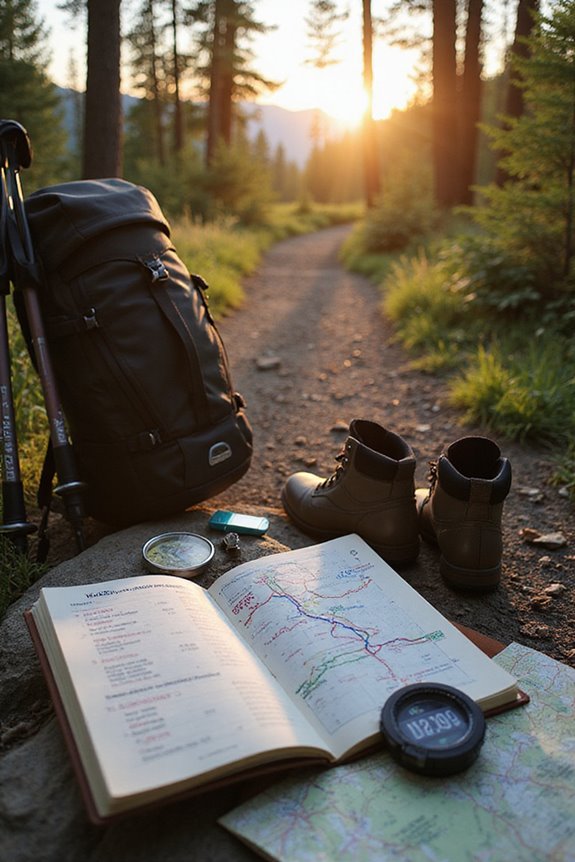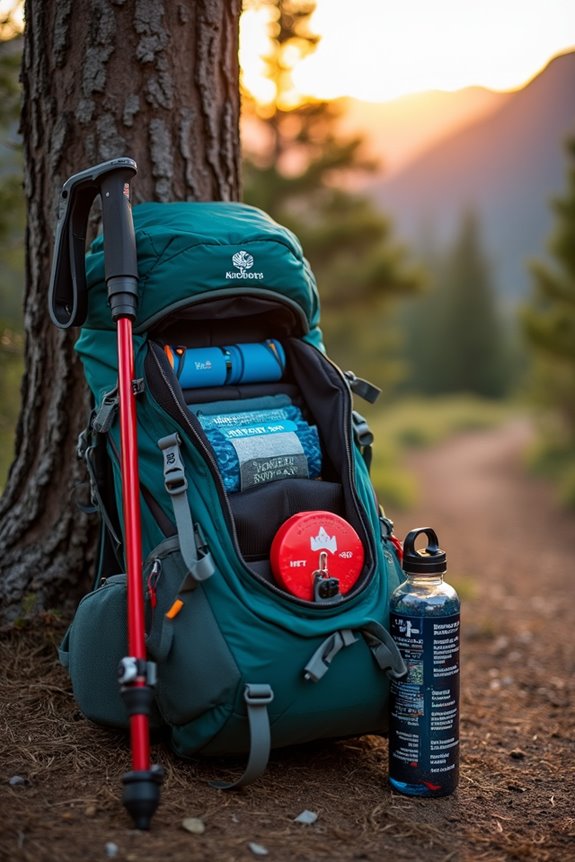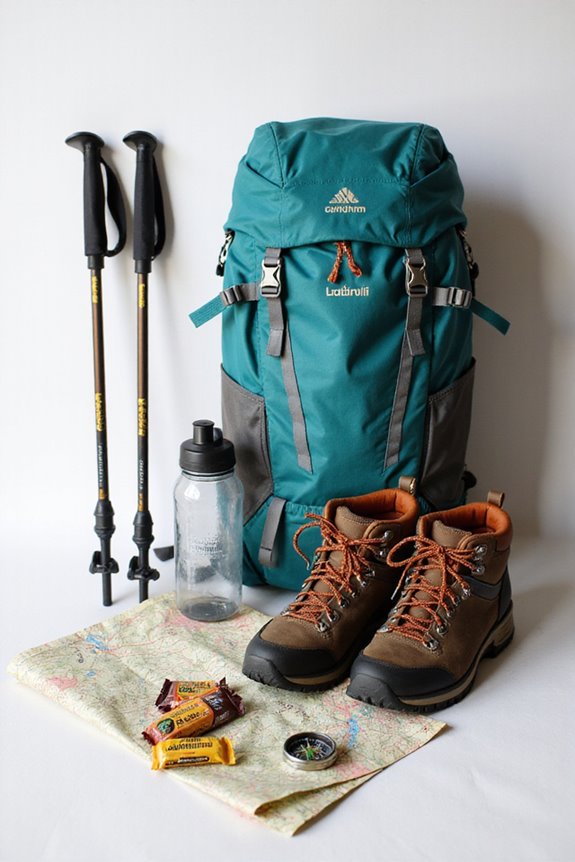To train for a hiking trip, focus on building both strength and endurance. Combine weight training with cardio like brisk walking or cycling to boost stamina. Hiking drills, like step-ups and lateral lunges, mimic trail challenges. Don’t forget to structure your schedule, balancing workouts with rest. Staying hydrated and fueling up with good nutrition is key for energy. Ready for an even more enjoyable trail experience? There’s so much more you can explore to enhance your hiking journey.
Key Takeaways
- Incorporate strength training to enhance muscle endurance and protect joints while hiking.
- Build cardiovascular endurance through activities like brisk walking, cycling, or interval training.
- Practice hiking-specific drills such as step-ups and lateral lunges to improve strength and balance.
- Structure your training schedule with a mix of aerobic workouts, strength training, and long hikes.
- Prioritize injury prevention strategies, including stretching, hydration, and using hiking poles for stability.
Understanding the Importance of Strength Training
When it comes to gearing up for a hiking trip, many folks might think that simply hitting the trails is enough to prepare, but they’d be missing a key ingredient: strength training. Building muscle endurance through focused workouts can greatly enhance hiking performance. For instance, strength training increases lean muscle mass, boosting endurance and power—ideal for those steep inclines. Not to mention, it’s essential for joint health; strong muscles protect joints, reducing the risk of injury. Imagine tackling a rocky path without the worry of knee pain! Plus, regular strength sessions help fend off fatigue, allowing hikers to explore longer with less exhaustion. So, before lacing up those boots, consider the power of strength training—it might just transform the hiking experience!
Building Cardiovascular Endurance

Building cardiovascular endurance is like giving your body the fuel it needs to tackle those breathtaking trails and conquer challenging hills. For hikers, this means embracing activities like brisk walking, cycling, or jogging. Interval training can be a game-changer—mixing steady-state cardio with short bursts of higher intensity mimics those pesky uphill climbs. Monitoring your heart rate is essential; staying in the right zone helps optimize gains without risking burnout. Aim for 3-5 cardio sessions weekly, gradually upping the duration and intensity. Remember, consistency is key! Incorporating nasal breathing techniques during steady workouts can enhance oxygen efficiency, ensuring that your body performs at its best. With improved endurance, the trails will feel less intimidating, and recovery will be quicker than ever!
Incorporating Hiking-Specific Practice

After building a solid foundation of cardiovascular endurance, it’s time to bring that fitness into the wild world of hiking. Incorporating hiking-specific practice is essential for mastering terrain navigation. Start with hiking drills like step-ups to boost glute and quadriceps strength—perfect for tackling those rocky climbs. Add heel-downs for calf control, ensuring safe descents. Don’t forget to mix in some jump squats for explosive power; they’ll prepare your legs for sudden changes in terrain. Lateral lunges come in handy too, helping you balance on uneven surfaces. And why not wear a loaded backpack during your workouts? It’s a great way to simulate the weight you’ll carry on the trail. Embrace these practices, and soon you’ll feel unstoppable!
Structuring Your Training Schedule

To successfully structure a training schedule for a hiking trip, it’s essential to find the right balance between pushing limits and allowing for recovery. A well-rounded plan might include alternating days of training intensity, where you mix aerobic workouts with strength training. Imagine tackling lunges one day and hitting the trails the next! Incorporating 1–3 conditioning days is crucial for building endurance, while scheduling one long hike weekly prepares you for those breathtaking views. Don’t forget the power of rest days; they’re your secret weapon against burnout and injuries. Strategically placing these recovery days after hard sessions helps your body bounce back. With the right structure, you’ll be ready to conquer those trails like a pro!
Injury Prevention and Recovery Strategies

Injury prevention and recovery strategies are essential for anyone gearing up for a hiking adventure, especially since the great outdoors can be as unpredictable as a squirrel on caffeine. To keep those pesky musculoskeletal injuries at bay, hikers should incorporate strength, stretching, and endurance training into their routine. Using hiking poles not only provides stability but also lowers the risk of ankle sprains and other extremity injuries. When it comes to recovery strategies, a gradual return to activity is key—think of it as easing back into your favorite chair after a long day. Engaging in stretching and strengthening exercises, along with proper post-hike care, like rest and hydration, can make all the difference in bouncing back from any setbacks.
Nutrition and Hydration for Optimal Performance
When gearing up for a hiking trip, it’s not just about the right gear and a sturdy pair of boots; the food and drink choices can make or break the adventure. Effective hydration strategies and macronutrient distribution are essential. Carbohydrates fuel muscles, while protein aids recovery, ensuring hikers feel less sore after those grueling treks. Aiming for a balanced intake—70% fats, 20% carbs, and 10% protein—can keep energy levels steady. Don’t forget to sip water and replenish electrolytes; dehydration can zap endurance and cloud thinking. Small, frequent meals help maintain energy balance, while post-hike recovery nutrition, rich in carbs and protein, prepares the body for the next day. Fuel wisely, and the trail will feel like a walk in the park!
Progress Tracking and Adaptation
Progress tracking and adaptation can transform a hiking enthusiast’s journey from a simple stroll into an epic adventure filled with personal victories. By employing effective tracking techniques, such as fitness apps or a trusty workout journal, hikers can monitor their weekly step averages, elevation gains, and even pack weights. This data isn’t just numbers; it’s the roadmap to improvement! Adaptation strategies are essential too—gradually increasing distance or pack weight by 10% each week helps build endurance without risking injury. And hey, alternating between distance and weight keeps things fresh and exciting. Incorporating strength training and allowing recovery days guarantees that hikers stay on track, ready to conquer those trails. With the right approach, every hike becomes a celebration of progress!
Frequently Asked Questions
What Are the Best Exercises for Improving Hiking Balance?
To improve hiking balance, individuals should focus on balance exercises such as single-leg squats and dynamic drills. Stability training, including the use of unstable surfaces, enhances coordination and prepares muscles for uneven terrain challenges.
How Long Should My Training Sessions Last?
Research indicates that training frequency and session intensity greatly impact endurance gains. Ideally, sessions should last 30-60 minutes initially, increasing to over 60 minutes for long hikes, ensuring gradual adaptation and preparation for upcoming challenges.
Can I Train for Hiking Indoors?
Indoor workouts can effectively prepare individuals for hiking. Engaging in cardio exercises such as rowing, cycling, and treadmill intervals enhances cardiovascular endurance, while strength training and balance drills improve the necessary muscles and stability for hiking adventures.
What Should I Wear During Training?
Amidst the ever-changing skies, proper attire for training includes moisture-wicking base layers, insulating mid-layers, and weather-resistant outer layers. Complement this with suitable training footwear, ensuring comfort and protection against diverse weather considerations encountered during outdoor sessions.
How Do I Choose the Right Hiking Gear?
Choosing the right hiking gear involves selecting appropriate hiking jackets for weather protection and durable trekking poles for stability. Prioritizing comfort, fit, and functionality guarantees an enjoyable experience on various terrains and conditions.





